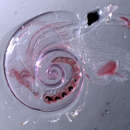pms
nòm ant ël fil


Die Atlantidae sind eine Familie der Pterotracheoidea (früher auch Heteropoda) innerhalb der Schnecken. Sie haben eine pelagische Lebensweise und leben räuberisch von Schnecken aus der Gruppe der Thecosomata.
Die Familie beinhaltet kleine Formen (ca. 1 cm) mit einem rechtsgewundenen, durchsichtigen und flachen Gehäuse mit einem Kiel. Es erinnert etwas an ein Gehäuse von Planorbis. Gehäuse und Kiel können mineralisiert sein (Atlanta), oder auch nur das Gehäuse (Protatlanta) oder Gehäuse und Kiel sind nicht mineralisiert (Oxygurus). Sie können sich im Gegensatz zu den Vertretern der anderen Familien der Pterotracheidae noch komplett in das Gehäuse zurückziehen und die Gehäuseöffnung mit einem Operculum verschließen. Der Weichkörper ist gallertartig und durchscheinend. Die Tiere schwimmen mit Hilfe des in eine Flosse umgewandelten Fußes auf dem Rücken. Der Kopf weist eine Schnauze und ein Paar lange Tentakeln auf, die vor den Augen sitzen. Die Augen sind hoch entwickelt und sitzen etwas über der Kopfoberfläche. Sie besitzen eine Linse. Auf dem Schwimmfuß sitzt ein muskulöser Saugnapf, mit dem die Beute festgehalten wird. Die lange Radula besitzt 7 Elemente pro Querreihe; einen Mittelzahn sowie einen Lateralzahn und zwei Marginalzähne beiderseits des Mittelzahns. Die Tiere sind getrenntgeschlechtlich. Die Männchen übertragen die Spermapakete mit dem Begattungsorgan in die Mantelhöhle. Die Entwicklung verläuft über eine planktotrophe (planktonfressende) Veliger-Larve.
Die Vertreter der Familie leben ausschließlich pelagisch im offenen Meer. Sie ernähren sich bevorzugt von anderen Schnecken des Planktons (Thecosomata oder Pteropoda). Die Beute wird mit Hilfe der Tentakeln erfasst und mit Hilfe des Saugnapfes am Fuß festgehalten, während das Tier mit Hilfe der Radula Stücke aus der Beute beißt.
Die Arten der Überfamilie leben weltweit in den oberen 200 Meter der wärmeren Meere. Viele Arten unternehmen tägliche Wanderungen in der Wassersäule, vom flachen Wasser während des Tages in tiefere Wasserschichten während der Nacht. Die Tiere sind schwerer als Wasser, d. h. während des Tages schwimmen sie permanent, um in der Wassersäule nicht langsam abzusinken. Abends scheiden die Tiere dann Schleimfäden aus, die die Tiere in der Wassersäule schwebend halten.
Derzeit werden drei Gattungen zur Familie gestellt[1]:
Die Atlantidae sind eine Familie der Pterotracheoidea (früher auch Heteropoda) innerhalb der Schnecken. Sie haben eine pelagische Lebensweise und leben räuberisch von Schnecken aus der Gruppe der Thecosomata.
Atlantidae is a family of sea snails, holoplanktonic gastropod molluscs in the clade Littorinimorpha.
According to taxonomy of the Gastropoda by Bouchet & Rocroi (2005) the family Atlantidae has no subfamilies.
The Atlantidae is a group of holoplanktonic gastropods, which all demonstrate a strong adaptation to pelagic life, in the form of a lenticular, laterally flattened, aragonitic shell, the surface of which is further enlarged by the presence of a wide, and very thin and fragile, double-walled keel.[1] The apex is on the right side of the shell, the umbilicus on the left.[1] For the living animal the enlargement of the shell’s surface serves ‘to increase stabilization during swimming and sinking’.[1] This phenomenon results in the occurrence of superficially very similar adult shells in separate species, whereas the larval shells may be utterly different.[1]
Their body size is microscopic with a shell diameter of less than 1 cm. The foot has evolved into a muscular swimming fin. Their swimming fin extends anteriorly beneath their head. They swim with their ventral part upward through undulation of their swimming fin.
The shell is coiled dextrally (i.e. clockwise). The thin, double-walled keel of the shell extends outward from the last shell whorl. The apex of the shell is found on the right side, the umbilicus on the left side. The shell and keel can be calcareous (genus Atlanta), or composed exclusively of conchiolin (genus Oxygyrus), or the shell can be calcareous and its keel composed of conchiolin (genus Protatlanta). The snails of this family can retract into their shell and close it off with a cartilaginous, flexible operculum.
Genera in the family Atlantidae include:
Recent Atlantidae, in the present concept, comprise three genera, two of which, Oxygyrus Benson, 1835, and Protatlanta Tesch, 1908, are considered monospecific.[1] In Protatlanta, however, a few additional fossil species have been described.[1] Both genera are characterised by partially uncalcified (conchiolin) shell portions.[1] Additional fossil genera considered to belong in the Atlantidae are Bellerophina d’Orbigny, 1843 (Cretaceous), Eoatlanta Cossmann, 1888 (Paleocene-Eocene) and Mioatlanta di Geronimo, 1974 (Miocene).[1] Only few Atlanta species are known from the fossil record, the oldest one being Atlanta arenularia Gougerot & Braillon, 1965 is from the Bartonian of the Paris Basin, which differs considerably from typical Atlanta by its cornucopia shape.[1]
Atlantids are negatively buoyant. During the day, they have to swim to maintain their position. At night they secrete strands of buoyant mucus to which they attach themselves. They are active predator locating their prey visually.
This article incorporates CC BY-3.0 text from the reference [1]
Atlantidae is a family of sea snails, holoplanktonic gastropod molluscs in the clade Littorinimorpha.
According to taxonomy of the Gastropoda by Bouchet & Rocroi (2005) the family Atlantidae has no subfamilies.
Les Atlantidae forment une famille de mollusques gastéropodes pélagiques, de l'ordre des Littorinimorpha.
Certaines organisations attribuent la création de cette famille à Wiegmann et Ruthe en 1832, toutefois selon le World Register of Marine Species ce serait Rang qui l'aurait décrite en premier en 1829.
Selon World Register of Marine Species (1 février 2016)[2] :
Les Atlantidae forment une famille de mollusques gastéropodes pélagiques, de l'ordre des Littorinimorpha.
Atlantidae is een familie van weekdieren uit de klasse van de Gastropoda (slakken).
Atlantidae is een familie van weekdieren uit de klasse van de Gastropoda (slakken).
Атлантиды[1] (лат. Atlantidae) — семейство планктонных морских брюхоногих моллюсков отряда Littorinimorpha. Голопланктонные организмы, демонстрирующие высочайшую адаптацию к пелагическому образу жизни. Раковина менее 1 см в диаметре.
В семействе Atlantidae 3 современных и 3 ископаемых рода[2][3]:
Атлантиды (лат. Atlantidae) — семейство планктонных морских брюхоногих моллюсков отряда Littorinimorpha. Голопланктонные организмы, демонстрирующие высочайшую адаптацию к пелагическому образу жизни. Раковина менее 1 см в диаметре.
海蝶螺科(學名:Atlantidae),也叫明螺科,是玉黍螺類支序之下一個全浮游(holoplanktonic(英语:holoplankton))海洋腹足綱軟體動物的科。
根據2005年的《布歇特和洛克羅伊的腹足類分類》,海蝶螺科之下並沒有再細分作亞科[2]。
海蝶螺科是一組全浮游的(英语:holoplanktonic)腹足綱海洋軟體動物。
他們有着微觀尺寸的身體,螺殼直徑小於或稍大於10mm[3]。腹足演化成可幫助游泳的盤狀腹鰭和尾部[3],並向前延伸至頭部底下。
螺殼平捲[3]右旋(即順時針方向)。口蓋及部分物種的殼體未完全鈣化,只由貝殼硬蛋白(conchiolin)構成[1],但亦因此而令其口蓋維持彈性[3]。 體表周圍有提高的龍骨板(keel)[3],但很薄很脆弱[1]。 外唇有深灣[3]。 生存於溫暖的水域[3]。 雖然這個科的物種都是浮游生物,但其身體卻是「負浮力」,日間要靠不斷游泳來保持身體浮在水面;而夜間就透過分泌出黏液來固定其身體[1]。
海蝶螺科包括下列各屬[1] :
最古老的海蝶螺屬物種Atlanta arenularia Gougerot & Braillon, 1965 的化石發現於巴黎盆地的Bartonian,其型態跟現時各海蝶螺屬物種相去甚遠[1]。
海蝶螺科(學名:Atlantidae),也叫明螺科,是玉黍螺類支序之下一個全浮游(holoplanktonic(英语:holoplankton))海洋腹足綱軟體動物的科。
根據2005年的《布歇特和洛克羅伊的腹足類分類》,海蝶螺科之下並沒有再細分作亞科。